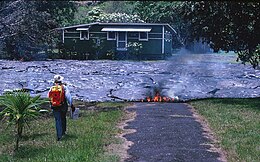Four types of unusual volcanic rocks have been recognised as erupting onto the surface of the Earth:
- Carbonatite and natrocarbonatite lavas are known from Ol Doinyo Lengai volcano in Tanzania, which is the sole example of an active carbonatite volcano.[9]
- Copper sulfide bearing lavas have been recognised from Chile and Bolivia[10]
- Iron oxide lavas are thought to be the source of the iron ore at Kiruna, Sweden, erupted in the Proterozoic, and in Chile associated with highly alkaline igneous rocks[11]
- Olivine nephelinite lavas are a unique type of lava that is thought to have come from much deeper in the mantle of the Earth.[12]
The term "lava" can also be used to refer to molten "ice mixtures" in eruptions on the icy satellites of the Solar system's gas giants[13].
Hazards
Lava flows are enormously destructive to property in their path but generally move slowly enough for people to get out of their way, though this is dependent on the viscosity of the lava; casualties caused directly by active lava flows are rare. Nevertheless injuries and deaths have occurred, either because people had their escape route cut off, because they got too close to the flow[14] or, more rarely, if the lava flow front travelled too quickly. This notably happened during the eruption of Nyiragongo in Zaire (now Democratic Republic of Congo) on 10 January 1977 when the crater wall was breached during the night and the fluid lava lake in it drained out in less than an hour. Flowing down the steep slopes of the volcano at up to 100 km/h, the lava swiftly overwhelmed several villages whilst their residents were asleep. As a result of this disaster, the mountain was designated a Decade Volcano in 1991[15].
Deaths attributed to volcanoes frequently have a different cause, for example volcanic ejecta, pyroclastic flow from a collapsing lava dome, lahars, poisonous gases that travel ahead of lava, or explosions caused when the flow comes into contact with water[14].
Towns destroyed by lava flows

- Kaimū, Hawaiʻi Destroyed by the eruption of the Kīlauea volcano in 1990. (abandoned)
- Kalapana, Hawaiʻi Destroyed by the eruption of the Kīlauea volcano in 1990. (abandoned)
- Kapoho, Hawaiʻi Destroyed by a lava flow from an eruption of Kīlauea on January 28, 1960. (abandoned)
- Keawaiki, Hawaiʻi (abandoned)
- Koaʻe, Hawaiʻi (abandoned)
- San Sebastiano al Vesuvio, Italy Destroyed in 1944 by the most recent eruption of Mount Vesuvius during the Allies' occupation of southern Italy. (rebuilt)
- Cagsawa, Philippines [16]
No comments:
Post a Comment